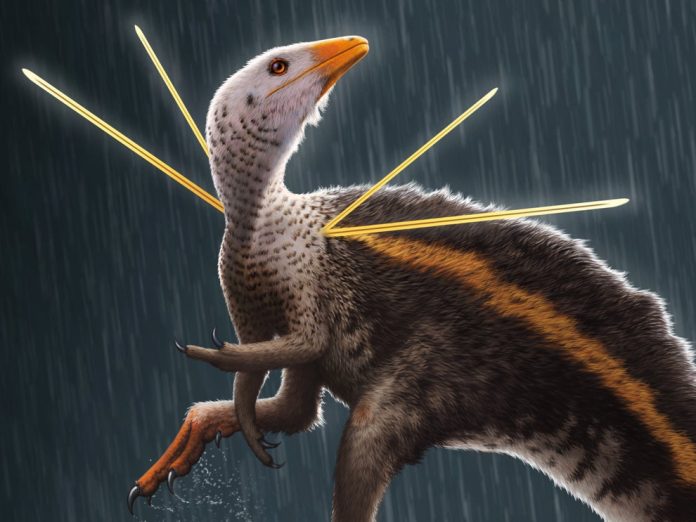A new chicken-sized dinosaur with flamboyant features used to attract mates or intimidate foes has been discovered.
Ubirajara jubatus, which lived about 110 million years ago, had elaborate plumage including a long fur mane and stiff ribbons projecting from its shoulders.
Researchers said these shoulder ribbons were not scales, fur or feathers and are believed to be unique to the animal. Each had a small sharp ridge running along the middle.
Scientists excavated the specimen from two slabs of stone and, using X-rays, found previously hidden skeletal elements and soft tissue – including a section of the long, thick mane running down the animal’s back that was preserved nearly intact. The arms were also covered in fur-like filaments down to the hands.
The dinosaur was discovered by an international team of scientists co-led by Professor David Martill and researcher Robert Smyth, both at the University of Portsmouth, and Professor Dino Frey at the State Museum of Natural History, Karlsruhe, Germany, who examined fossil records kept at the museum.
Their research pointed to the mane being controlled by muscles allowing it to be raised, similar to how a porcupine raises its spines when it feels threatened.
Professor Martill said: “What is especially unusual about the beast is the presence of two very long, probably stiff ribbons on either side of its shoulders that were probably used for display, for mate attraction, inter-male rivalry or to frighten off foes.
”We cannot prove that the specimen is a male, but given the disparity between male and female birds, it appears likely the specimen was a male, and young, too, which is surprising given most complex display abilities are reserved for mature adult males.
“Given its flamboyance, we can imagine that the dinosaur may have indulged in elaborate dancing to show off its display structures.”
Mr Smyth said that the dinosaur’s plumage might have improved its chances of survival.
He said: “We know lots of dinosaurs had bony crests, spines and frills that were probably used for display but we don’t see these very often in living birds. In birds, crests are made of feathers.
”This little dinosaur provides some insight into why this might be the case.
“Bone requires a lot of energy for a body to grow and maintain, it’s also heavy and can cause serious injury if broken.
”Keratin – the material that makes up hair, feathers and scales – is a much better display alternative for a small animal like this one. Keratin is less costly for a body to produce, it’s also lightweight, flexible and can be regularly replaced if damaged.
“Ubirajara is the most primitive known dinosaur to possess integumentary display structures. It represents a revolution in dinosaur communication, the effects of which we can still see today in living birds.”
Ubirajara jubatus is closely related to the European Jurassic dinosaur Compsognathus – one of the smallest known dinosaurs, which was a fast runner with a long neck and tail, strong hind limbs and small forelimbs.
The study is published in the scientific journal Cretaceous Research.





























